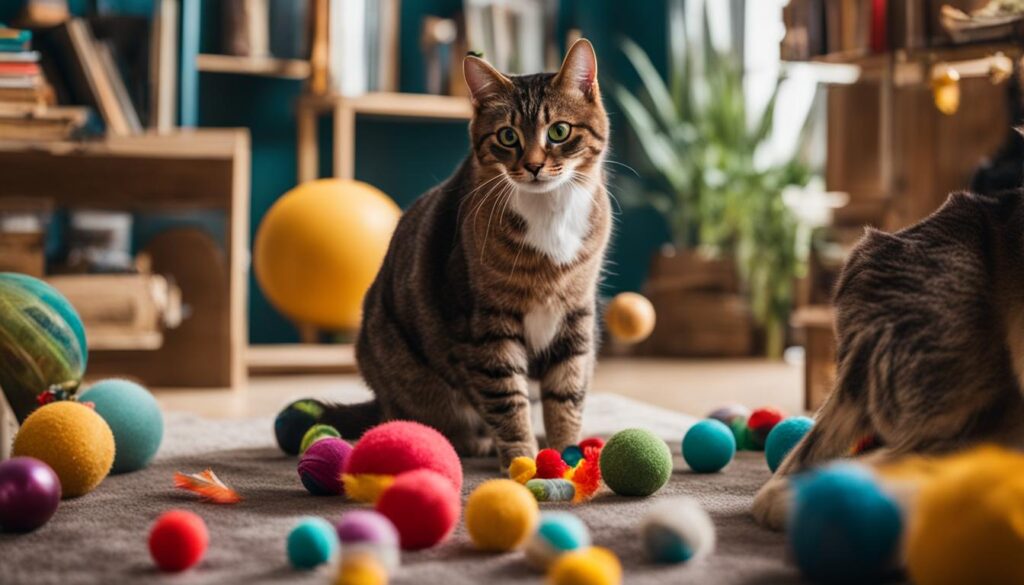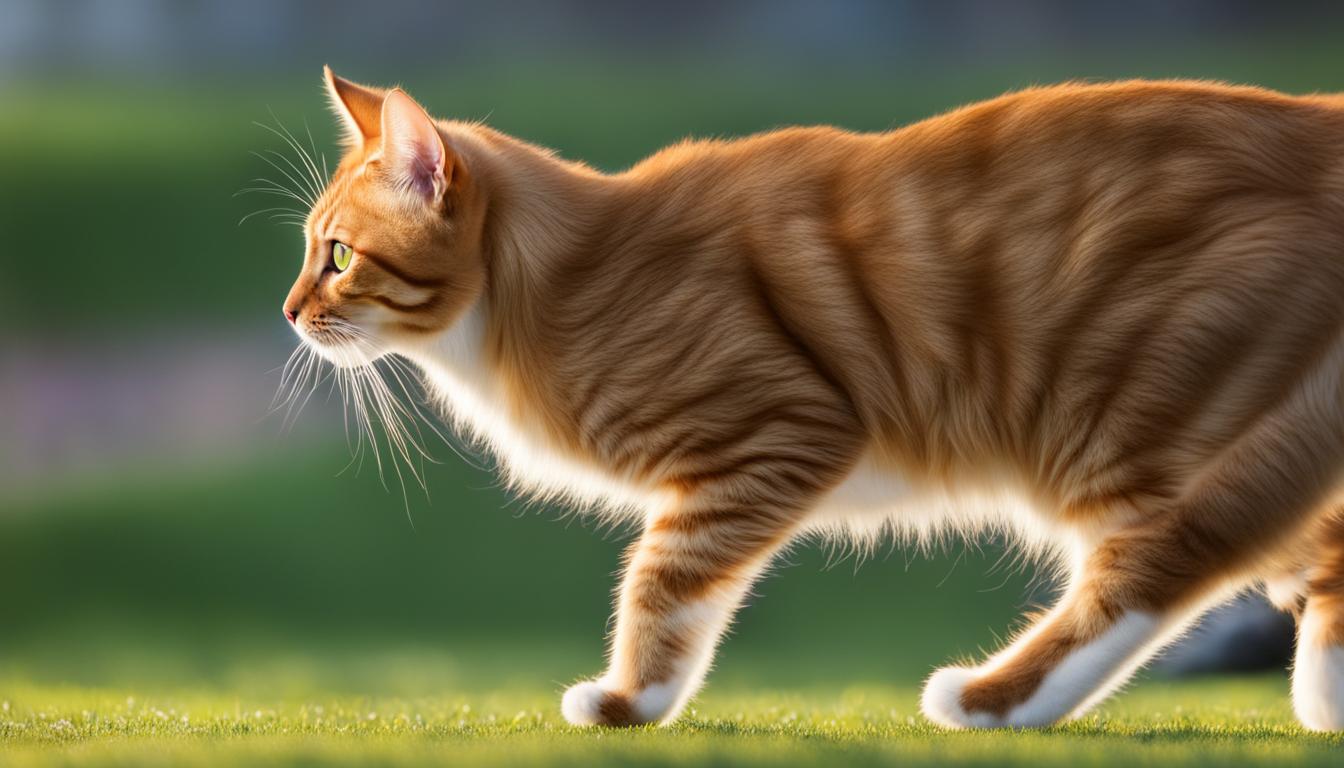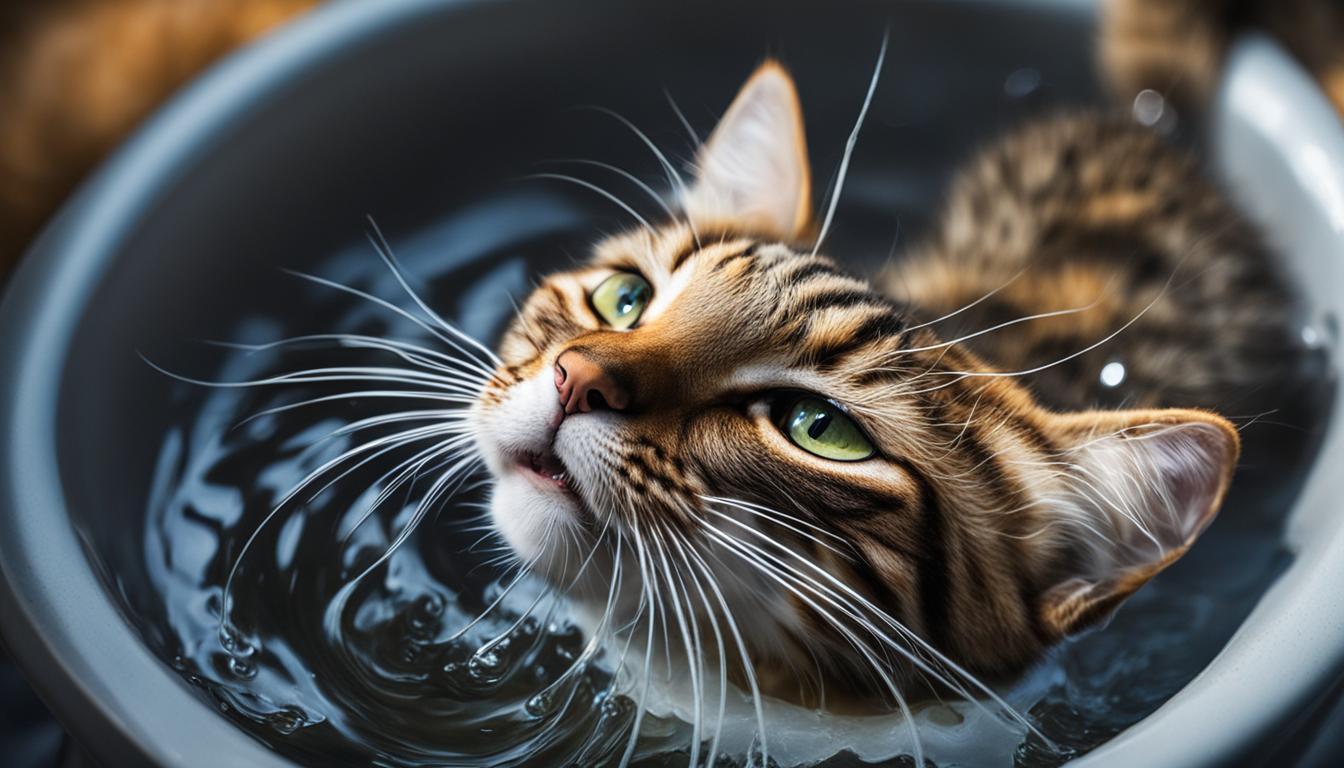Have you ever wondered why your cat can’t resist pouncing on that toy mouse or chasing after a feather wand? It turns out, there’s a fascinating science behind the playtime antics of our feline friends. The physics of a cat’s play is a marvel, as toys are cleverly designed to mimic the movements of prey, captivating and engaging their natural hunting instincts.
When I watch my own cat leap and stalk with such precision, I can’t help but be in awe of their abilities. That’s why I dove into the world of feline play physics to uncover the secrets behind their captivating behaviors. So, let’s explore the science behind why cat toys perfectly mimic the movements of prey and how they create an extraordinary playtime experience for our beloved kitties.
Key Takeaways:
- The physics of a cat’s play involves toys that mimic the movements of prey.
- Cat toys engage a cat’s natural hunting instincts and provide mental and physical stimulation.
- Understanding the science behind cat toys can help us appreciate their remarkable playtime experiences.
- Choosing the right toys can enhance a cat’s playtime and ensure they lead happy and fulfilling lives.
- Cat toys are designed to replicate the unpredictable and enticing motions that prey would make in the wild.
The Fascinating World of Feline Balance
Cats are well-known for their remarkable balance and agility, and their ability to effortlessly navigate even the most precarious of surfaces. But have you ever wondered how they achieve such precision in their movements? The answer lies in their feline balance, a fascinating combination of anatomy and sensory systems that allows them to maintain equilibrium and perform acrobatic feats that seem almost gyroscopic in nature.
One key component of a cat’s balance is their specialized vestibular system, located in their inner ears. This intricate system of fluid-filled canals and sensory cells provides crucial information about the cat’s position and movement in space. It acts like a built-in gyroscope, constantly monitoring changes in the cat’s head position and orientation, allowing them to adjust their body accordingly.
Another important factor in feline balance is their tail. While many may think of a cat’s tail as simply an expressive appendage, it actually plays a vital role in their acrobatic abilities. The tail acts as a counterbalance, shifting in coordination with the cat’s body movements to maintain stability and control. The combination of their vestibular system and their tail working together creates a remarkably precise and agile sense of balance.
Understanding the Mechanics of Feline Balance
“Cats possess an unparalleled sense of balance, enabling them to navigate even the most narrow and treacherous of paths with ease.” – Dr. Emily Wilson, Feline Behavior Specialist
By understanding the mechanics of feline balance, we gain insight into the incredible capabilities of our feline companions. It is a testament to their evolutionary adaptations and their natural inclination to explore their surroundings with grace and poise. So the next time you see your cat effortlessly leaping onto a high shelf or walking along a narrow ledge, take a moment to appreciate their gyroscopic-like abilities and the fascinating world of feline balance.
Feline Balance: Key Factors
| Factor | Description |
|---|---|
| Vestibular System | A specialized system in the inner ears that provides information about a cat’s position and movement in space, serving as a built-in gyroscope. |
| Tail | An important counterbalance that shifts in coordination with the cat’s body movements to maintain stability and control. |
The Importance of Indoor Play for Cats
Keeping cats indoors provides a safe and protected environment for them, shielding them from potential dangers such as predators, parasites, and illnesses. However, it’s crucial to recognize that indoor cats require ample opportunities for play and mental stimulation to prevent boredom and potential health issues, like obesity.
Interactive toys and engaging playtime with their human companions can keep indoor cats physically and mentally engaged, ensuring a happy and healthy lifestyle. Regular play sessions not only provide exercise but also help cats fulfill their natural hunting instincts, preventing boredom and promoting overall well-being.
To prevent your indoor cat from becoming restless or sedentary, it’s essential to provide a variety of interactive toys that cater to their hunting and play behaviors. These toys can range from puzzle toys that stimulate their cognitive abilities to interactive wand toys that mimic the movements of prey. By engaging in play with your cat, you strengthen the bond between you and provide essential mental and physical stimulation.
The Benefits of Indoor Play for Cats
Indoor play offers numerous benefits for cats:
- Physical exercise: Regular play sessions help keep indoor cats active, preventing weight gain and associated health problems.
- Mental stimulation: Interactive toys challenge cats’ problem-solving skills, keeping their minds sharp and preventing boredom.
- Emotional well-being: Playtime helps alleviate stress, anxiety, and frustration, promoting a positive and contented disposition.
- Bonding time: Engaging in play with your cat strengthens your relationship and trust, fostering a deep and meaningful connection.
| Toy Type | Benefits |
|---|---|
| Interactive wand toys | Mimic prey movements, providing exercise and mental stimulation |
| Puzzle toys | Require problem-solving skills, engaging cats’ cognitive abilities |
| Treat-dispensing toys | Promote mental stimulation and reward cats’ natural curiosity |
| Scratching posts and climbers | Provide exercise and help maintain healthy claws |
“Play is essential for a cat’s overall well-being. It keeps them physically fit, mentally sharp, and emotionally fulfilled. By offering a variety of toys and engaging in interactive play, we can enrich the lives of our indoor cats and provide them with the playtime they need to thrive.”
By understanding the importance of indoor play for cats and providing them with stimulating toys and playtime, we can ensure that our feline friends lead happy and fulfilled lives. So let’s embrace the world of cat toys and make playtime a daily priority for our beloved indoor cats.

Creating the Ultimate Playtime Experience: Choosing the Right Cat Toys
When it comes to providing the ultimate playtime experience for your cat, it’s important to choose toys that offer both mental stimulation and physical exercise. Cat toys are not just a source of entertainment; they also play a crucial role in keeping our feline friends happy and engaged. To ensure that your cat has an enriching playtime, here are some tips for selecting the right toys:
- Consider your cat’s preferences: Just like humans, cats have their own unique personalities and toy preferences. Some cats may enjoy chasing feathers or playing with toys that make noise, while others might prefer interactive puzzle toys or laser pointers. Observe your cat’s play behaviors and experiment with different types of toys to find the ones that they enjoy the most.
- Choose toys that offer mental stimulation: Cats are intelligent creatures, and they need toys that challenge their minds. Look for toys that require problem-solving skills, such as puzzle toys or treat-dispensing toys. These types of toys can keep your cat mentally engaged and prevent boredom.
- Opt for toys that mimic prey movements: Cats are natural hunters, and toys that mimic the movements of prey can provide them with a satisfying hunting experience. Wand toys with feathers or toys that simulate the unpredictable movements of small animals can be particularly appealing to cats. These toys not only provide physical exercise but also tap into their natural instincts.
By choosing a variety of toys that cater to your cat’s preferences and offer both mental stimulation and physical exercise, you can create the ultimate playtime experience for your feline friend. Remember to rotate the toys regularly to keep the playtime exciting and engaging. So go ahead, indulge your cat with toys that will keep them entertained and stimulated!

Toy Recommendations for Mental Stimulation and Exercise
| Toy | Description |
|---|---|
| Interactive puzzle toys | These toys require your cat to solve a puzzle or manipulate objects to get a treat, providing mental stimulation and exercise. |
| Feather wand toys | Wand toys with feathers mimic the movements of birds, enticing your cat to chase and pounce, engaging their hunting instincts. |
| Treat-dispensing toys | These toys hold treats that are released as your cat plays with them, rewarding them for their efforts and keeping them mentally engaged. |
| Laser pointers | The elusive red dot of a laser pointer can provide endless entertainment and exercise for your cat as they chase and pounce on it. |
Understanding Your Cat’s Unique Personality and Toy Preferences
When it comes to cat toys, one size does not fit all. Just like humans, cats have their own individual personalities and preferences when it comes to playtime. Some cats may be more interested in toys that make noise or have feathers, while others may prefer interactive puzzle toys or laser pointers. As a cat owner, it’s important to observe your feline friend’s behavior and preferences to find the toys that they enjoy the most.
Experimenting with different types of toys is key to discovering your cat’s favorite playthings. Not only does this provide entertainment for your furry companion, but it also helps stimulate their natural hunting instincts. Whether it’s a wand toy that mimics the movements of prey or an interactive puzzle toy that challenges their problem-solving skills, finding the right toys for your cat can provide them with hours of entertainment.
Factors to Consider
When selecting toys for your cat, there are a few factors to keep in mind. Firstly, consider your cat’s age. Kittens may prefer toys that encourage more active play, such as small balls or toys on springs. Older cats, on the other hand, may enjoy toys that provide mental stimulation, such as treat-dispensing puzzles. Additionally, take into account your cat’s energy level and play style. Some cats may be more active and require toys that allow for chasing and pouncing, while others may prefer toys they can bat around on their own.
Remember to rotate your cat’s toys regularly to keep things interesting. Cats can quickly become bored with the same toys, so swapping them out periodically can help maintain their engagement. You can also try incorporating catnip or treats into certain toys to make them even more enticing. By catering to your cat’s unique personality and play preferences, you can ensure they have a fulfilling and enjoyable playtime experience.
| Toy Type | Description | Benefits |
|---|---|---|
| Interactive Puzzle Toys | Toys that require problem-solving skills to obtain treats or rewards. | Provides mental stimulation and helps prevent boredom. |
| Wand Toys | Toys with feathers or imitation prey attached to a wand or string. | Mimics the movements of prey and encourages active play. |
| Laser Pointers | A small handheld device that emits a red laser dot. | Allows for interactive play and satisfies a cat’s natural instinct to chase. |
| Balls and Rolling Toys | Small balls or toys that roll or spin. | Encourages independent play and satisfies a cat’s curiosity. |
Remember, no two cats are exactly alike. What works for one cat may not necessarily work for another. By observing your cat’s behavior, considering their age and energy level, and providing a variety of toys, you can find the perfect playtime companions that cater to your cat’s unique personality and preferences.

Table: Comparison of the Best Toys for Indoor Cats
| Toy | Description | Benefits |
|---|---|---|
| Interactive Puzzle Toys | Require problem-solving to access treats or kibble hidden inside a puzzle | Provide mental stimulation and engage problem-solving skills |
| Teaser Wands | Feature feathers or bells to mimic prey movements | Fulfill hunting instincts and encourage active play |
| Automatic Laser Pointers | Move the laser randomly, simulating the movements of small prey | Offer exercise and mental stimulation without fixation on the laser light |
| Electronic Interactive Toys | Respond to your cat’s movements, activating sounds or movements | Provide entertainment even when you’re not available to play |
Conclusion
As a cat owner, I’ve come to appreciate the immense benefits of cat toys in enhancing my feline companion’s playtime experience. Not only do these toys provide mental and physical stimulation, but they also tap into a cat’s natural hunting instincts, bringing out their inner predator. By engaging in interactive play and choosing the right toys, we can create a playtime environment that is both challenging and rewarding for our beloved cats.
Playtime is essential for cats, as it allows them to release pent-up energy, exercise their muscles, and sharpen their hunting skills. Cat toys contribute to their overall well-being by preventing boredom and providing an outlet for their natural instincts. Watching our cats pounce, chase, and bat at their toys is not only entertaining but also serves as a reminder of their incredible agility and grace.
By understanding the physics behind how cat toys mimic prey movements, we can gain a deeper appreciation for the craftsmanship and ingenuity that goes into designing these toys. The way they replicate the unpredictable motions of prey is a testament to the thoughtfulness and dedication of toy manufacturers. It’s truly amazing how a simple toy can provide endless entertainment for our feline friends.
So, let’s embrace the world of cat toys and offer our cats the playtime they deserve. By incorporating a variety of toys that cater to their individual preferences, we can keep our feline companions mentally and physically engaged. Let’s make playtime a priority and watch our cats thrive as they engage in the instinctual behaviors that bring them joy. After all, a happy and fulfilled cat is a healthier cat!
FAQ
How do cat toys mimic the movements of prey?
Cat toys are designed to replicate the unpredictable and enticing motions that prey would make in the wild. They use physics to mimic the movements of prey, engaging a cat’s natural hunting instincts.
Why are cats such graceful acrobats?
Cats exhibit incredible balance and agility due to their unique anatomy and sensory systems. Their inner ears and specialized vestibular system play a crucial role in maintaining equilibrium, while their tails aid in balance, contributing to their gyroscopic-like abilities.
Why is indoor play important for cats?
Keeping cats indoors provides a safe environment, protecting them from predators, parasites, and illnesses. However, indoor cats still need play and mental stimulation to prevent boredom and potential health issues, such as obesity.
How do I choose the right cat toys for my cat?
To provide the ultimate playtime experience, it’s important to choose toys that offer mental stimulation and physical exercise. Scratching posts, cat trees, interactive puzzle toys, and toys that mimic prey movements are all great options.
How do I know what types of toys my cat will enjoy?
Each cat has a unique personality and individual preferences when it comes to toys. Observe your cat’s play behaviors and preferences to find the toys they enjoy the most. Experimenting with different types of toys can help you discover their favorites.
What are some recommended toys for indoor cats?
Recommended toys for indoor cats include roller circuit toys, teaser wands, automatic laser pointers, electronic interactive toys, and puzzle toys. Each of these toys offers different benefits and engages various hunting and play behaviors.
Why are cat toys important for cats?
Cat toys play a crucial role in providing mental and physical stimulation for our feline friends. They satisfy a cat’s natural hunting instincts, prevent boredom, and promote a happy and fulfilling lifestyle.





